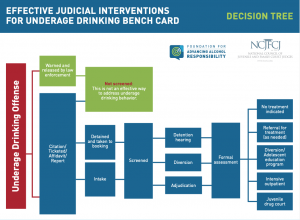Effective Judicial Interventions for Underage Drinking Bench Card
Overview
The Problem: Underage Drinking
Alcohol is the most widely abused substance among America’s adolescents and its toll on youth, their families and communities is serious. The reasons teens decide to drink are multifactorial and complex. Some of the reasons that teens drink range from attempts to self-medicate, unknown or unmet mental health issue(s), the widespread notion that drinking is part of growing up, the physical and emotional feelings that arise from drinking, social influences, easy access and/or parental acceptance of drinking. Effective judicial responses to a youth’s drinking require an evaluation of its root causes. Developmentally appropriate interventions should be incorporated into the juvenile justice system’s responses to underage drinking.
Decision Tree

For more information please visit www.icmcourtacademy.org/course/underage-drinking-a-guide-for-judges/.
Why Screen and Assess?
When an adolescent is referred to the juvenile court for an alcohol related offense or there is information that alcohol use was involved in an offense, it is important to ensure that youth has been screened for an alcohol problem. Screenings are brief assessment tools and should be completed as early in the case as possible. If the screening reveals an alcohol problem, the youth should be referred for a more comprehensive and in-depth formal assessment. A licensed evaluator or another trained professional should complete an alcohol/substance abuse evaluation as early as possible to determine the clinically appropriate level of treatment needed. A key piece to making a referral is to follow up and ensure the child and family has completed the assessment. Any clinical treatments recommended should be incorporated into the disposition. Without a formal assessment/evaluation, the court may not have the information about what services would be beneficial to the child.
Treatment Options for Underage Drinking Offenders
If a youth has been assessed as having a problem with alcohol use, it is vital they receive an appropriate treatment plan, which should be developed in a collaborative process with probation, community providers and the family. Judges and other court professionals should rely on the results of the screening and assessment tools as well as the professional judgment of treatment providers when making decisions about treatment options.
Identifying Community Resources
Creating a community resource map or inventory will ensure judges know what programs are available and effective. Courts should map services in their community from prevention through intervention. Making sure that the providers and services in your jurisdiction appropriately meet the needs of youth, both in capacity and efficacy, is a key component to inventorying resources. Once an inventory is completed, create a list or map of providers in an effort to match services to needs of the individual.
Judicial Leadership
A significant aspect of a systems-level approach to underage drinking is judicial leadership. Judges can play a role in curbing underage drinking and achieving better case outcomes by becoming more involved with strategies and programs aimed at tackling the problem of underage drinking in their jurisdiction. Judges can educate the community about the consequences of underage drinking and the need for effective treatment options.
Save this page to your device. Tap and then "Add to Home Screen".
Save this page to your device. Open the browser option menu by tapping the top right menu icon and tap on Add to homescreen.
